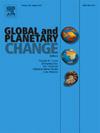Widespread upper-ocean deoxygenation in the Alpine-Mediterranean Tethys during the Toarcian Oceanic Anoxic Event
IF 4
1区 地球科学
Q1 GEOGRAPHY, PHYSICAL
引用次数: 0
Abstract
The early Toarcian (∼183 Ma) was characterized by pronounced climate warming associated with massive release of 13C-depleted carbon to the exogenic system, as evidenced by globally recognized negative carbon-isotope excursions (N-CIE) in biospheric carbon reservoirs. Global warming during this interval triggered a variety of environmental perturbations, of which large-scale marine deoxygenation (as indicated by the presence of widespread organic carbon-rich deposits) is arguably diagnostic and led to the naming of the interval in question as the Toarcian Oceanic Anoxic Event (T-OAE). Nevertheless, the spatial variability of water-column redox during the T-OAE is unclear because most sedimentological and geochemical methods used to infer marine redox are likely reflective of bottom-water and/or pore-water conditions. Here we report new I/(Ca + Mg) and Cerium (Ce)-anomaly data from two carbonate successions from northern Italy that encompass the T-OAE interval. Both successions were deposited in the Alpine-Mediterranean Tethys; one in a shallow-water platform setting and the other within a pelagic environment. Both successions record an abrupt drop in I/(Ca + Mg) values, coupled with positive excursions in Ce-anomaly records at the onset of the T-OAE N-CIE. The synchronized changes in marine iodate depletion and Ce enrichment suggest widespread and significant upper-ocean deoxygenation in the Alpine-Mediterranean Tethys. This redox pattern is attributed to an expanded oxygen minimum zone (OMZ) formed as a result of sluggish oceanic circulation under climate warming, augmented by enhanced dissolved oxygen consumption due to increased nutrient availability and the consequent eutrophication in both proximal and distal settings. Because reduced seawater dissolved oxygen [O2] would increase the ecological stress and constrict any potentially hospitable habitats, the broad synchroneity between biotic turnovers and upper-ocean deoxygenation in the Alpine-Mediterranean Tethys is compatible with a potential causal link.
托阿克洋缺氧事件期间阿尔卑斯-地中海特提斯大范围上层海洋脱氧
托阿尔早期(183 Ma ∼)的特点是气候明显变暖,同时向外源系统大量释放 13C 贫化碳,全球公认的生物圈碳库负碳同位素偏移(N-CIE)就是证明。在这一时期,全球变暖引发了各种环境扰动,其中大规模的海洋脱氧(如广泛存在的富含有机碳的沉积物所示)可以说是诊断性的,并导致将这一时期命名为托阿尔西元海洋缺氧事件(T-OAE)。然而,T-OAE 期间水柱氧化还原作用的空间变化尚不清楚,因为大多数用于推断海洋氧化还原作用的沉积学和地球化学方法可能反映的是底层水和/或孔隙水条件。在此,我们报告了来自意大利北部两个碳酸盐岩组的新的 I/(Ca + Mg)和铈(Ce)异常数据,这些数据涵盖了 T-OAE 时段。这两个演替都沉积在阿尔卑斯-地中海特提斯地区;一个在浅水平台环境中,另一个在浮游环境中。两个演替都记录了 I/(Ca + Mg)值的突然下降,同时在 T-OAE N-CIE 开始时,Ce-异常记录出现了正偏移。海洋碘酸盐耗竭和铈富集的同步变化表明,阿尔卑斯-地中海特提斯大范围的上层海洋严重脱氧。这种氧化还原模式是由于气候变暖导致大洋环流缓慢而形成的最小含氧区(OMZ)扩大,而营养物质供应的增加又加剧了溶解氧的消耗,从而导致近海和远海富营养化。由于海水溶解氧[O2]的减少会增加生态压力,并限制任何潜在的宜居生境,阿尔卑斯-地中海特提斯的生物转化与上层海洋脱氧之间的广泛同步性与潜在的因果关系相吻合。
本文章由计算机程序翻译,如有差异,请以英文原文为准。
求助全文
约1分钟内获得全文
求助全文
来源期刊

Global and Planetary Change
地学天文-地球科学综合
CiteScore
7.40
自引率
10.30%
发文量
226
审稿时长
63 days
期刊介绍:
The objective of the journal Global and Planetary Change is to provide a multi-disciplinary overview of the processes taking place in the Earth System and involved in planetary change over time. The journal focuses on records of the past and current state of the earth system, and future scenarios , and their link to global environmental change. Regional or process-oriented studies are welcome if they discuss global implications. Topics include, but are not limited to, changes in the dynamics and composition of the atmosphere, oceans and cryosphere, as well as climate change, sea level variation, observations/modelling of Earth processes from deep to (near-)surface and their coupling, global ecology, biogeography and the resilience/thresholds in ecosystems.
Key criteria for the consideration of manuscripts are (a) the relevance for the global scientific community and/or (b) the wider implications for global scale problems, preferably combined with (c) having a significance beyond a single discipline. A clear focus on key processes associated with planetary scale change is strongly encouraged.
Manuscripts can be submitted as either research contributions or as a review article. Every effort should be made towards the presentation of research outcomes in an understandable way for a broad readership.
 求助内容:
求助内容: 应助结果提醒方式:
应助结果提醒方式:


